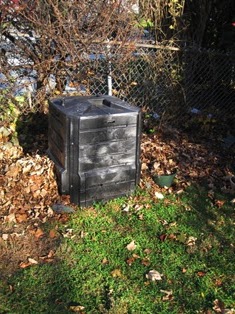So what does it take?
1. Brown stuff (carbon)
Dry leaves, cardboard, paper printed with soy-based ink, dry hay, wood shavings from your local carpenter... To start your bin, fill it at least halfway with dry leaves. Then begin adding green stuff:
2. Green stuff (nitrogen)
Grass clippings, coffee grounds, egg shells, tea bags, apple cores, bell pepper seeds, that brown pear you just found in the fruit bowl.
3. Water
Too much will drown your bacteria, but too little will kill them too. Sprinkle some water when you add brown stuff, just enough to make dry leaves shiny.
4. Air
Anaerobic bacteria don't need air to eat your trash and convert it to dirt, but they produce ammonia as a waste product (ew) and are slow digesters. To encourage oxygen-eating aerobic bacteria, efficient decay, and a clean smelling compost bin, stir your pile once a week to replenish oxygen supplies.
What to avoid:
- Oil, meat and bones, dairy: Homegrown compost piles are not efficient enough to break these down. Meat and dairy also encourage mice, rats, and even feral cats and dogs to nose around in your bin.
- Pest-infested plants, or weeds that have gone to seed - they'll both love the compost. A little too much.
- Pet poop. Those little droppings can contain parasites or other diseases.
How do I start?
Many cities subsidize compost bins - I got mine from Cambridge for $40, which included a container to collect kitchen trash. You can also build your own - just make sure it's sturdy enough to keep out rats, etc. All you need are four walls, chicken fencing for the bottom, and a cover for the top.
Place the bin in a sunny spot. Throw some twigs in as the bottom layer. They will help keep air flowing to the bottom of your pile. Then throw in a lot of dry brown leaves, sprinkle with water, and start to add green stuff. Simple!
How does it work?
Lots of little critters will start to eat the food.Compost This Book! has a cute illustration showing centipedes, earthworms, snails and beeetles gathered around a dinner table. You can't even see the biggest eaters - bacteria. They all produce waste - nutrient-rich dirt, sometimes called black gold. Don't worry about cultivating pests. The centipedes are so happy in your compost bin, why would they decide to come inside?
Another waste product is heat. The more they eat, the more they heat. A hot compost is a fast compost.
Will it stink?
If your compost stinks, it either needs more air or more brown stuff. Experiment to find a well-balanced diet.
What do I do with it?
Next fall, scoop out the finished, and nearly-finished, compost from the bottom of the bin (store-bought bins come with a sliding door contraption that lets you get at the pile from the bottom) and throw it on your garden, especially around the roots of the plants you want to fertilize. Then cover it with some leaves or hay, and you're set for winter. Even if your compost isn't fully matured (decomposed) right now, it will be by next spring.
I'm a pretty lazy composter because I don't stir the pile very often and often my mix is out of balance. Still, stuff decays. It's pretty amazing to me how my bucketfuls of kitchen crap can shrink down into rich, dark dirt.


No comments:
Post a Comment